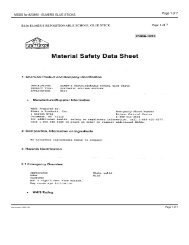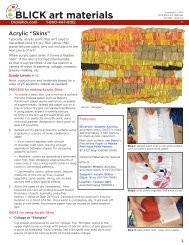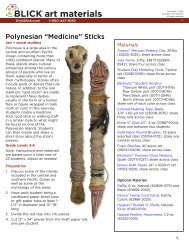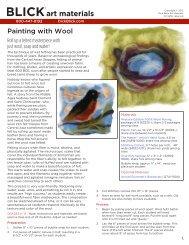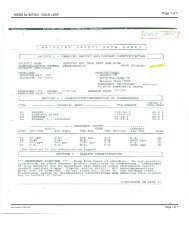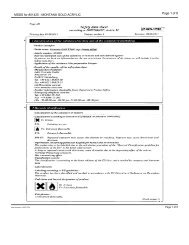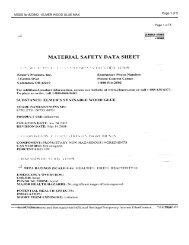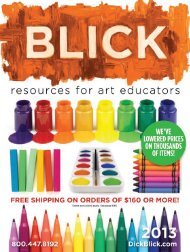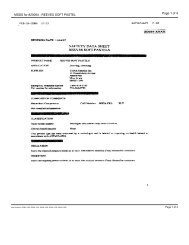Towers and Turrets - Dick Blick - Dick Blick Art Materials
Towers and Turrets - Dick Blick - Dick Blick Art Materials
Towers and Turrets - Dick Blick - Dick Blick Art Materials
You also want an ePaper? Increase the reach of your titles
YUMPU automatically turns print PDFs into web optimized ePapers that Google loves.
<strong>Towers</strong> <strong>and</strong> <strong>Turrets</strong><br />
This lesson plan gives students the<br />
opportunity to learn about the concept<br />
of architecture, particularly towers <strong>and</strong><br />
turrets.<br />
Using watercolor painting techniques<br />
<strong>and</strong> tracing, cutting, <strong>and</strong> gluing skills,<br />
students create lines, patterns <strong>and</strong><br />
textures while underst<strong>and</strong>ing the concept<br />
of near being larger, far being smaller<br />
Grade Levels 3-6<br />
Note: instructions <strong>and</strong> materials based on a<br />
class of 25 students. Adjust as needed.<br />
Objectives<br />
After completing this lesson, students<br />
would be able to:<br />
- Draw r<strong>and</strong>om straight lines.<br />
- Use a straight edge <strong>and</strong> compass to<br />
draw lines <strong>and</strong> shapes.<br />
- Define a checkered pattern.<br />
Preparation<br />
1. “Architecture”, as defined by Webster”s<br />
dictionary, is “the art or practice of<br />
designing <strong>and</strong> building structures <strong>and</strong><br />
especially habitable ones.”<br />
Have examples ready to show students<br />
different styles of architecture, for<br />
instance, Classical, the Parthenon vs.<br />
Modern, Frank Lloyd Wright's<br />
Fallingwater. Be sure to include pictues<br />
of buildings with towers <strong>and</strong> turrets,<br />
some suggestions:<br />
- The Taj Mahal in India<br />
- Saint Basil’s Cathedral in Mosco<br />
- Angkor Wat temple in Cambodia<br />
- Saint Andrew's Church of Kiev<br />
- Saint Sophia Cathedral in Novgorod<br />
- The Ubudiah Mosque in Malaysia<br />
2. Discuss the function of towers, turrets,<br />
domes, etc.<br />
Process<br />
1. Paint the background first. On the sheet<br />
of watercolor paper, using clean water<br />
<strong>and</strong> the large, flat brush, cover the entire<br />
sheet with water. Work quickly as the<br />
water evaporates. Dab the brush in the<br />
blue paint <strong>and</strong> touch it around various<br />
<strong>Materials</strong><br />
<strong>Blick</strong> Watercolor Paper (10008-1018), 15" x 22"<br />
sheet, need one per student<br />
Spectra ® Paper Squares (60942-1002), share<br />
one package of 200 sheets across class<br />
Origami Metallic Squares (11206-0369), share<br />
two 36-sheet packages across class<br />
<strong>Blick</strong> Glue Sticks, .74-oz White (23872-1020),<br />
need one per student<br />
Prang ® Watercolor Sets (00305-1029), share<br />
one 8-color set between two students<br />
Liqui-Mark ® Fine Line Markers (21220-0200),<br />
share one 200-piece classpack<br />
<strong>Blick</strong> Economy Graphite Pencils (20302-2009),<br />
box of 12, need one per student<br />
<strong>Blick</strong> Scholastic Pony Hair Brushes, Round,<br />
size 10 (05865-1010) <strong>and</strong> Bright, size 16<br />
(05864-1016) need one each per student<br />
Holbein ® Watercolor Atomizer Bottle<br />
(02912-1003), share one between two students<br />
Tonic Studios ® Kids’ Scissors (57150-6005),<br />
need one per student<br />
Water Jars<br />
Paper Towels<br />
1.
places on the paper, watching it spread<br />
with the water. Dab areas with red <strong>and</strong><br />
purple, too, until the color covers the<br />
page.<br />
2. Next, have one student hold their painting<br />
up over a row of paper towels <strong>and</strong><br />
another student spray water across the<br />
top of the painting. The colors will run<br />
down <strong>and</strong> run together, drawn by gravity<br />
<strong>and</strong> the pull of the water.<br />
3. Place on a drying rack <strong>and</strong> allow to dry.<br />
4. Next, students create a magical city of<br />
towers <strong>and</strong> turrets out of colored paper.<br />
Each tower will be a basic rectangle<br />
shape. The towers that are farthest away<br />
will be smaller, the ones that are closest<br />
will be larger. Students will create six<br />
towers of varying sizes. NOTE: have<br />
students create the towers first, then the<br />
domed tops.<br />
Cover the towers with colorful patterns<br />
<strong>and</strong> windows, using fine-line markers. Cut<br />
the towers into interesting shapes by<br />
folding the rectangle, drawing the shape<br />
on the side away from the fold, then<br />
cutting it out.<br />
5. Glue the towers to the page. Smallest<br />
ones first, largest ones in front.<br />
6. Create a dome to fit at the top of each<br />
tower (it should overlap). Use the metallic<br />
paper, draw the dome on the plain side,<br />
then cut it out. Glue a dome on each<br />
tower. As an option, wrinkle the dome,<br />
then smooth it out again <strong>and</strong> glue it<br />
down. Outline each tower <strong>and</strong> dome with<br />
a marker.<br />
7. Add more designs with cut scraps of<br />
paper <strong>and</strong> glue them in place.<br />
National St<strong>and</strong>ards<br />
Content St<strong>and</strong>ard #1 — Underst<strong>and</strong>ing <strong>and</strong> applying media,<br />
techniques, <strong>and</strong> processes<br />
K-4 Students use art materials <strong>and</strong> tools in a safe <strong>and</strong><br />
responsible manner<br />
5-8 Students select media, techniques, <strong>and</strong> processes;<br />
analyze what makes them effective or not effective in<br />
communicating ideas; <strong>and</strong> reflect upon the effectiveness<br />
of their choices<br />
Content St<strong>and</strong>ard #2 — Using knowledge of structures <strong>and</strong><br />
functions<br />
K-4 Students know the differences among visual<br />
characteristics <strong>and</strong> purposes of art in order to convey<br />
ideas<br />
5-8 Students employ organizational structures <strong>and</strong><br />
analyze what makes them effective or not effective in<br />
the communication of ideas<br />
Content St<strong>and</strong>ard #4 —Underst<strong>and</strong>ing the visual arts in<br />
relation to history <strong>and</strong> cultures<br />
K-4 Students identify specific works of art as<br />
belonging to particular cultures, times, <strong>and</strong> places<br />
5-8 Students describe <strong>and</strong> place a variety of art<br />
objects in historical <strong>and</strong> cultural contexts<br />
Lesson Plan <strong>and</strong> <strong>Art</strong>work submitted by<br />
Anne Pietropola, Mechanicsburg, PA<br />
Copyright © 2004 <strong>Dick</strong> <strong>Blick</strong> <strong>Art</strong> <strong>Materials</strong>. All rights reserved.<br />
2.



